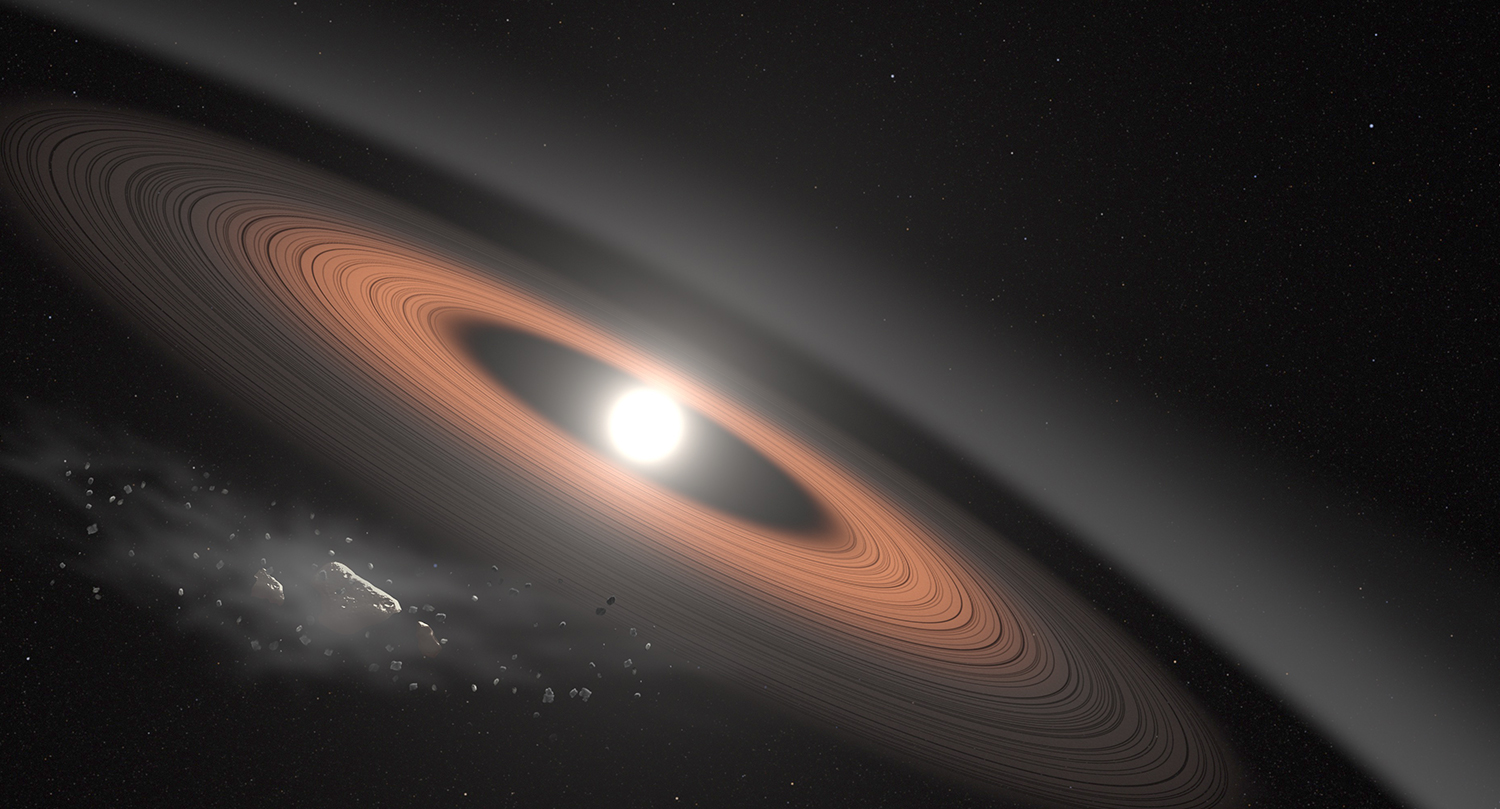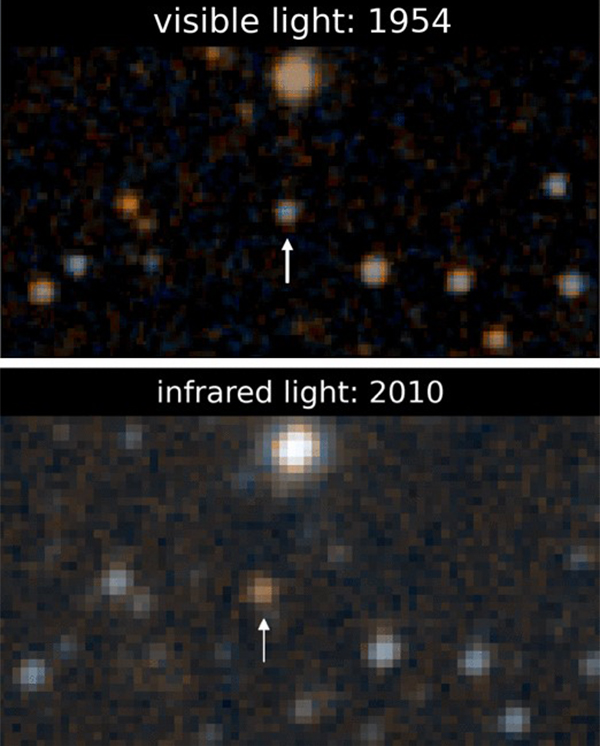
Astronomers Invite Citizens to Crowd-Source New Worlds
Relaunch of Backyard Worlds project coincides with latest discovery of ‘white dwarf J0207’
Published Date
By:
- Cynthia Dillon
Share This:
Article Content

In this illustration, an asteroid (bottom left) breaks apart under the powerful gravity of LSPM J0207+3331, the oldest, coldest white dwarf known to be surrounded by a ring of dusty debris. Scientists think the system’s infrared signal is best explained by two distinct rings composed of dust supplied by crumbling asteroids. Image courtesy of NASA’s Goddard Space Flight Center/Scott Wiessinger
Astronomers, such as the University of California San Diego’s Adam Burgasser, are often pictured as lonely figures, staying up all night at remote telescopes, searching for distant worlds. However, these scientists are increasingly turning to ordinary citizens for help exploring the universe, through projects such as Backyard Worlds: Planet 9. A relaunch of this project coincides with an Astrophysical Journal Letters publication of an exciting new discovery in our own celestial backyard—an unusual white dwarf star that challenges the way astronomers think about the long-term evolution of planetary systems.
Since the Backyard Worlds project began in 2017, it has discovered more than 1,000 cold, nearby brown dwarfs—dim stars with too little mass to fuse hydrogen in their cores. But the newly identified neighbor is instead a white dwarf—a faint, dense remnant from the long past death of a normal star. Scientifically labeled LSPM J0207+3331, or “J0207” for short, it is surrounded by a warm, dusty circumstellar disk that appears unusually bright in images from NASA’s WISE mission. The scientists reporting its discovery believe that its disk may be composed of more than one distinct ring-like component—an arrangement never before seen in circumstellar material surrounding a white dwarf.
Impressively, J0207 was first reported by citizen scientist Melina Thévenot of Germany, who found the star using Backyard World’s online interface. Upon reporting her discovery, Burgasser, a collaborator on the Backyward Worlds team, obtained critical follow-up observations with the Keck II telescope on the summit of Mauna Kea in Hawaii, one of the world’s premier astronomical observing facilities. Using a newly commissioned instrument called NIRES, Burgasser made observations that allowed the team to identify the discovery as a cool white dwarf, and accurately determine the structure of its disk.
“The Keck observations were critical to determine the nature of this remarkable system,” said Burgasser, who regularly uses Keck to study cold brown dwarfs. “The new, very sensitive NIRES instrument allowed us to identify the source as a white dwarf and rule out its extra reddening as being due to a brown dwarf companion. For once, I was happy to not find a brown dwarf!”
According to Thévenot, one of more than 150,000 citizen scientists who have contributed to the Backyard Woods project, a really motivating aspect of the search is that researchers move their telescopes to look at worlds citizens have discovered. “What I especially enjoy, though, is the interaction with the awesome research team. Everyone is very kind, and they are always trying to make the best out of our discoveries.”

Backyard Worlds: Planet 9 volunteers scour infrared images from NASA, searching animated blinks for moving objects in our cosmic neighborhood. Like other white dwarf stars, J0207 shows a bluish tinge in visible light (top), but also sports a strikingly orange hue in the infrared (bottom), indicating the unexpected presence of circumstellar dust rings. More discoveries displaying subtle infrared motion will be unlocked by the expanded Backyard Worlds re-launch data set. Image courtesy of Digitized Sky Survey/WISE/NEOWISE, Aaron Meisner (NOAO)
Thevenot’s white dwarf has an anomalous debris disk surrounding it—one differing from similar disks found around other white dwarfs which are thought to result from the continual breakup of small rocky planetesimals orbiting these stars. But J0207, with an age of roughly three billion years, is nearly three times older, and much colder, than any other white dwarf known to feature such a disk.
“This white dwarf is so old that whatever process is feeding material into its ring must operate on billion-year timescales,” said John Debes, an astronomer at the Space Telescope Science Institute in Baltimore and lead author of the J0207 study, co-authored by Thévenot, and to which Burgasser contributed. “Most of the models scientists have created to explain rings around white dwarfs only work well up to around 100 million years, so this star is really challenging our assumptions of how planetary systems evolve.”
According to Aaron Meisner, one of four co-founders who include Marc Kuchner (principal investigator), Adam Schneider and Jackie Faherty—of the Backyard Worlds project which is aimed at searching for cold worlds near the sun, no single astronomer could single-handedly study all of the WISE images by eye to find these cold worlds. Additionally, a completely automated search is not possible due to noise and artifacts in the WISE images. So, Backyard Worlds’ solution is an online interface that presents large cohorts of volunteers with animated “flipbooks” of WISE images in which to visually search for moving objects.
“Professional researchers routinely use supercomputers and machine learning, but there’s still no substitute for the human eye when it comes to recognizing subtle motions in astronomical images,” said Meisner, an astronomer at the National Optical Astronomy Observatory in Tucson, Arizona.
The crowd-sourcing approach appears to be working. Since the project’s inception two years ago, Backyard Worlds volunteers have made more than one new celestial discovery per day. Citizen scientists are encouraged to use images from NASA’s WISE mission, through the Zooniverse web portal, to uncover previously overlooked objects in the Sun’s local cosmic neighborhood. The newly upgraded Backyard Worlds interface is expected to unleash a new wave of additional discoveries.
Backyard Worlds: Planet 9 is a collaboration between NASA, the American Museum of Natural History in New York, Arizona State University, National Optical Astronomy Observatory, the Space Telescope Science Institute in Baltimore, the University of California San Diego, Bucknell University, the University of Oklahoma and Zooniverse, a collaboration of scientists, software developers and educators who collectively develop and manage citizen science projects on the internet.
NASA's Jet Propulsion Laboratory in Pasadena, California, manages and operates WISE for NASA's Science Mission Directorate. The WISE mission was selected competitively under NASA's Explorers Program managed by the agency's Goddard Space Flight Center. The science instrument was built by the Space Dynamics Laboratory in Logan, Utah. The spacecraft was built by Ball Aerospace & Technologies Corp. in Boulder, Colorado. Science operations and data processing take place at the Infrared Processing and Analysis Center at Caltech, which manages JPL for NASA.
Share This:
You May Also Like
Stay in the Know
Keep up with all the latest from UC San Diego. Subscribe to the newsletter today.


